Tamil numerals
| Numeral systems |
|---|
| Hindu–Arabic numeral system |
| East Asian |
| Alphabetic |
| Former |
| Positional systems by base |
| Non-standard positional numeral systems |
| List of numeral systems |
| Part of a series on |
| Tamils |
|---|
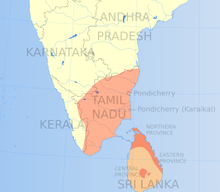 |
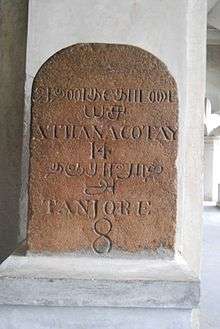
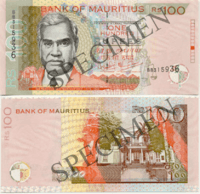
Tamil numerals (Tamil: தமிழ் எண்கள், இலக்கங்கள்), refers to the numeral system of the Tamil language used officially in Tamil Nadu and Singapore, as well as by the other Tamil-speaking populations around the world including Mauritius, Sri Lanka, Malaysia, Réunion, and South Africa, and other emigrant communities around the world. Traditionally Vattezhuttu characters were used, but now Arabic numerals have become commonplace.
Basic numbering
Zero
Old Tamil possesses a special numerical character for zero (see Old Tamil numerals below) and it is read as andru (literally, no/nothing). But yet Modern Tamil renounces the use of its native character and uses Arabic, 0. Modern Tamil words for zero include சுழியம் (suzhiyam) or பூச்சியம் (poocciyam).
Cardinal numbers (முதல் எண்கள்)
| Modern Tamil script | Tamil numeral | Tamil word and pronunciation |
|---|---|---|
| ௦ | 0 | சுழியம் (sūḻiyam); Old Tamil பாழ் (pāḻ)[1] |
| ௧ | 1 | ஒன்று (oṉṟu) |
| ௨ | 2 | இரண்டு (iraṇṭu) |
| ௩ | 3 | மூன்று (mūṉṟu) |
| ௪ | 4 | நான்கு (nāṉku) |
| ௫ | 5 | ஐந்து (aintu) |
| ௬ | 6 | ஆறு (āru) |
| ௭ | 7 | ஏழு (ēḻu) |
| ௮ | 8 | எட்டு (eṭṭu) |
| ௯ | 9 | ஒன்பது (oṉpatu) |
| ௰ | 10 | பத்து (pattu) |
Transcribing other numbers
Reproductive and Attributive prefixes
Tamil has a numeric prefix for each number from 1 to 9, which can be added to the words for the powers of ten (ten, hundred, thousand, etc.) to form multiples of them. For instance, the word for fifty, ஐம்பது (aimpathu) is a combination of ஐ (ai, the prefix for five) and பத்து (paththu, which is ten). The prefix for nine changes with respect to the succeeding base 10. தொ+ the unvoiced consonant of the succeeding base 10 forms the prefix for nine. For instance, 90 is தொ+ண் ('ண்' being the unvoiced version of 'ணூ'), hence, தொண்ணூறு).
| Modern Tamil script | Tamil prefix | Transliteration |
|---|---|---|
| ௧ | ஓர் | ōr |
| ௨ | ஈர் | īr |
| ௩ | மூ | mū |
| ௪ | நான் | nāṉ |
| ௫ | ஐ | ai |
| ௬ | ஆறு | āṟ(u) |
| ௭ | ஏழ் | ēḻ(u) |
| ௮ | எண் | eņ |
| ௯ | தொன் | ton |
These are typically void in the Tamil language except for some Hindu and Christian religious references, example 'அட்ட இலட்சுமிகள்' (the eight Lakshmis) in a Hindu context, or 'ஏக பாலன்' (One son) in a Christian context. However, it should be noted, that even in religious contexts Tamil language is usually more preferred for its more poetic nature and relatively low incidence of consonant clusters.
Specific characters
Unlike other Indian languages, Tamil has distinct digits for 10, 100, and 1000. It also has distinct characters for other number-based aspects of day-to-day life.
| 10 | 100 | 1000 |
|---|---|---|
| ௰ | ௱ | ௲ |
| day | month | year | debit | credit | as above | rupee | numeral |
|---|---|---|---|---|---|---|---|
| ௳ | ௴ | ௵ | ௶ | ௷ | ௸ | ௹ | ௺ |
Multiples of ten (பதின்பெருக்கம்)
There are two numeral systems that can be used in the Tamil language: the Tamil system which is as follows
The following are the traditional numbers of the Ancient Tamil Country, Tamizhakam.
| Rank | 101 | 102 | 103 | 104 | 105 | 106 | 109 | 1012 | 1015 | 1018 | 1020 | 1021 |
|---|---|---|---|---|---|---|---|---|---|---|---|---|
| Words | பத்து | நூறு | ஆயிரம் | பத்தாயிரம் | நூறாயிரம் | மெய்யிரம் | தொள்ளுண் | ஈகியம் | நெளை | இளஞ்சி | வெள்ளம் | ஆம்பல் |
| Character | ௰ | ௱ | ௲ | ௰௲ | ௱௲ | ௲௲ | ௲௲௲ | ௲௲௲௲ | ௲௲௲௲௲ | ௲௲௲௲௲௲ | ௱௲௲௲௲௲௲ | ௲௲௲௲௲௲௲ |
| Reading | pathu | nūru | āyiram | pattāyiram | nūraiyiram | meiyyiram | tollun | īkiyam | neļai | iļañci | veļļam | āmpal |
Tamil-System
| Rank | 105 | 106 | 107 | 108 | 109 | 1011 | 1013 | 1015 | 1017 | 1019 | 1021 | 1025 |
|---|---|---|---|---|---|---|---|---|---|---|---|---|
| Words | இலட்சம் | பத்து இலட்சம் | கோடி | பத்து கோடி | அற்புதம் | நிகர்ப்புதம் | கர்வம் | சங்கம் | அர்த்தம் | பூரியம் | முக்கொடி | மாயுகம் |
| Character | ௱௲ | ௲௲ | ௰௲௲ | - | ௱௲௲ | ௲௲௲ | ௲௲௲௲ | ௲௲௲௲௲ | ௲௲௲௲௲௲ | ௱௲௲௲௲௲௲ | ௲௲௲௲௲௲௲ | ௰௲௲௲௲௲௲௲ |
| Reading | lațcham | pathu lațcham | kōdi | pathu kōdi | aṟputam | nikarputam | karvam | saṅkam | arttam | pūriyam | mukkoți | māyukam |
Partitive numerals (பகுத்தல்)
Fractions (பின்னம்)
Transcribing fractions (பின்னம் எழுத்தல்)
You can transcribe any fraction, by affixing -இல் (-il) after the denominator followed by the numerator. For instance, 1/41 can be said as நாற்பத்து ஒன்றில் ஒன்று (naatpaththu ondr-il ondru).
The suffixing of the -இல் (-il) requires you to change the last consonant of the number to its இ (i) form. For example, மூன்று+இல் (moondru+il) becomes மூன்றில் (moondr-il); note the உ (u) has been omitted.
Common fractions (பொது பின்னங்கள்)
Common fractions have names already allocated to them, hence, these names are often used rather than the above method.
| Rank | 1⁄4 | 1⁄2 | 3⁄4 | 1⁄5 | 1⁄8 | 1⁄10 | 1⁄16 | 1⁄20 | 1⁄40 | 1⁄80 | 1⁄160 |
|---|---|---|---|---|---|---|---|---|---|---|---|
| Character | கால் | அரை | முக்கால் | நாலுமா | அரைக்கால் | இருமா | மாகாணி, வீசம் | ஒருமா | அரைமா | காணி | அரைக்காணி |
| Reading | kāl | arai | mukkāl | nālumā | araikkāl | irumā | mākāni, vīsam | orumā | araimā | kāni | araikkāni |
Other fractions are:
| 1 | ஒன்று | onṛu |
| 3⁄4 = 0.75 | முக்கால் | mukkāl |
| 1⁄2 = 0.5 | அரை | arai |
| 1⁄4 = 0.25 | கால் | kāl |
| 1⁄5 = 0.2 | நாலுமா | nālumā |
| 3⁄16 = 0.1875 | மும்மாகாணி | mummākāni |
| 3⁄20 = 0.15 | மும்மா | mummā |
| 1⁄8 = 0.125 | அரைக்கால் | araikkāl |
| 1⁄10 = 0.1 | இருமா | irumā |
| 1⁄16 = 0.0625 | மாகாணி (வீசம்) | mākāṇi (vīsam) |
| 1⁄20 = 0.05 | ஒருமா | orumā |
| 3⁄64 = 0.046875 | முக்கால்வீசம் | mukkāl vīsam |
| 3⁄80 = 0.0375 | முக்காணி | mukkāṇi |
| 1⁄32 = 0.03125 | அரைவீசம் | araivīsam |
| 1⁄40 = 0.025 | அரைமா | araimā |
| 1⁄64 = 0.015625 | கால் வீசம் | kāl vīsam |
| 1⁄80 = 0.0125 | காணி | kāṇi |
| 3⁄320 = 0.009375 | அரைக்காணி முந்திரி | araikkāṇi munthiri |
| 1⁄160 = 0.00625 | அரைக்காணி | araikkāṇi |
| 1⁄320 = 0.003125 | முந்திரி | munthiri |
| 3⁄1280 = 0.00234375 | கீழ் முக்கால் | kīl mukkal |
| 1⁄640 = 0.0015625 | கீழரை | kīlarai |
| 1⁄1280 = 7.8125×10−4 | கீழ் கால் | kīl kāl |
| 1⁄1600 = 0.000625 | கீழ் நாலுமா | kīl nalumā |
| 3⁄5120 ≈ 5.85938×10−4 | கீழ் மூன்று வீசம் | kīl mūndru vīsam |
| 3⁄6400 = 4.6875×10−4 | கீழ் மும்மா | kīl mummā |
| 1⁄2500 = 0.0004 | கீழ் அரைக்கால் | kīl araikkāl |
| 1⁄3200 = 3.12500×10−4 | கீழ் இருமா | kīl irumā |
| 1⁄5120 ≈ 1.95313×10−4 | கீழ் வீசம் | kīl vīsam |
| 1⁄6400 = 1.56250×10−4 | கீழொருமா | kīlorumā |
| 1⁄102400 ≈ 9.76563×10−6 | கீழ்முந்திரி | kīl̠ munthiri |
| 1⁄2150400 ≈ 4.65030×10−7 | இம்மி | immi |
| 1⁄23654400 ≈ 4.22754×10−8 | மும்மி | mummi |
| 1⁄165580800 ≈ 6.03935×10−9 | அணு | aṇu |
| 1⁄1490227200 ≈ 6.71039×10−10 | குணம் | kuṇam |
| 1⁄7451136000 ≈ 1.34208×10−10 | பந்தம் | pantham |
| 1⁄44706816000 ≈ 2.23680×10−11 | பாகம் | pāgam |
| 1⁄312947712000 ≈ 3.19542×10−12 | விந்தம் | vintham |
| 1⁄5320111104000 ≈ 1.87966×10−13 | நாகவிந்தம் | nāgavintham |
| 1⁄74481555456000 ≈ 1.34261×10−14 | சிந்தை | sinthai |
| 1⁄1489631109120000 ≈ 6.71307×10−16 | கதிர்முனை | kathirmunai |
| 1⁄59585244364800000 ≈ 1.67827×10−17 | குரல்வளைப்படி | kuralvaḷaippidi |
| 1⁄3575114661888000000 ≈ 2.79711×10−19 | வெள்ளம் | veḷḷam |
| 1⁄357511466188800000000 ≈ 2.79711×10−21 | நுண்மணல் | nuṇṇmaṇal |
| 1⁄2323824530227200000000 ≈ 4.30325×10−22 | தேர்த்துகள் | thērtthugal |
Anu was considered as lowest fraction by ancient Tamils as size of smallest physical object (similar to an atom). Later, this term went to Sanskrit to refer directly to atoms.
Decimals (பதின்மம்)
Decimal point is called புள்ளி (pulli) in Tamil. For example, 1.1 would be read as ஒன்று புள்ளி ஒன்று (ondru pulli ondru).
Percentage (விழுக்காடு)
Percentage is known as விழுக்காடு (vil̠ukkādu) in Tamil or சதவீதம் (sathavītham). These words are simply added after a number to form percentages. For instance, four percent is நான்கு சதவீதம் (nāngu sathavītham) or நான்கு விழுக்காடு (nāngu vil̠ukkādu). Percentage symbol (%) is also recognised and used.
Ordinal numbers (வரிசை எண்கள்)
Ordinal numbers are formed by adding the suffix -ஆம் (aam) after the number, except for 'First'.
| Ordinal | Tamil | Transliteration |
|---|---|---|
| First | முதல் | mudhal |
| Second | இரண்டாம் | irandām |
| Third | மூன்றாம் | mūnṟām |
| Fourth | நான்காம் | nānkām |
| 101st | நூற்று ஒன்றாம் | nūṟṟu onṟām |
Collective numerals (கூட்டெண்கள்)
| English | Tamil | Transliteration |
|---|---|---|
| Single | ஒற்றை | oṟṟai |
| Pair | இரட்டை | iraṭṭai |
| Reproductives | ௺+ வினைச்சொல் | Numeric prefix + noun* |
| Single (pillar), double (pillar)... | ஒருக்(கால்), இருக்(கால்)- | orukkāl, irukkāl* |
| Distributives | ௺+ முறை | Numeric prefix + muṟai |
| Once, twice... | ஒருமுறை, இருமுறை | orumuṟai, irumuṟai |
- As always, when blending two words into one, an unvoiced form of the consonant as the one that the second starts with, is placed in between to blend.
Traditional Tamil counting song
This song is a list of each number with a concept its primarily associated with.
| Tamil | Transliteration | English | ||||||||||
|---|---|---|---|---|---|---|---|---|---|---|---|---|
| ஒரு குலம் | ōrkulam | One race | ||||||||||
| ஈரினம் | īrinam | Two sexes-ஆண் (aaN-Male), பெண்(peN-Female) | ||||||||||
| முத்தமிழ் | muttamizh | Three sections of Tamil-இயல் (iyal-Literature), இசை (isai-Music) and நாடகம் (Nātakam-Drama) | ||||||||||
| நான்மறை | Nānmarai | Four scriptures | ||||||||||
| ஐம்புலன் | aimbulan | Five senses | ||||||||||
| அறுசுவை | Arusuvai | Six tastes(inippu, kaarppu, kasappu, pulippu, uvarppu, thuvarppu) | ||||||||||
| ஏழிசை | ēzhicai | Seven musical notes(kural, thuththam, kaikkiLai, uzhai, iLi, viLari and thAram) | ||||||||||
| எண்பக்கம் | Eṇpakkam | Eight directions(kizhaku merku vadaku therku then-merku then-kizhaku vada-merku vada-kizhaku) | நவமணிகள் | வைரம் | மரகதம் | நீலம் | கோமேதகம் | பவளம் | மாணிக்கம் | முத்து | புட்பராகம் | வைடூரியம் |
| தொன்மெய்ப்பாடு | Tonmeippāṭu | Also known as NAVARASAM as per the Dance expressions. Those are Uvakai – Joyful, nakai – Humour, azhukai - cries, vekuli – Innocent, perumitam – Proud, achcham – Fear, ilivaral – Disgust, marutkai – wonder, amaiti - Tranquility[2] |
Influence
As the antique classical language of the Dravidian languages, Tamil numerals influenced and shaped the numerals of the others in the family. The following table compares the main Dravidian languages.
| Number | Tamil | Kannada | Malayalam | Tulu | Telugu | Kolami | Kurukh | Brahui | Proto-Dravidian |
|---|---|---|---|---|---|---|---|---|---|
| 1 | onru | ondu | onnu | onji | okaṭi | okkod | oṇṭa | asiṭ | *oru(1) |
| 2 | iraṇṭu | eraḍu | raṇṭu | raḍḍ | renḍu | irāṭ | indiŋ | irāṭ | *iru(2) |
| 3 | mūnru | mūru | mūnnu | mūji | mūḍu | mūndiŋ | mūnd | musiṭ | *muC |
| 4 | nālu, nānku | nālku | nālu | nāl | nālugu | nāliŋ | nākh | čār (II) | *nān |
| 5 | ainthu, añju | aidu | añcu | ayN | ayidu | ayd 3 | pancē (II) | panč (II) | *cayN |
| 6 | āru | āru | āru | āji | āru | ār 3 | soyyē (II) | šaš (II) | *caru |
| 7 | ēlu | ēlu | ēlu | yēl | ēḍu | ēḍ 3 | sattē (II) | haft (II) | *ēlu |
| 8 | yeṭṭu | eṇṭu | eṭṭu | edma | enimidi | enumadī 3 | aṭṭhē (II) | hašt (II) | *eṭṭu |
| 9 | onpatthu | ombattu | onpatu | ormba | tommidi | tomdī 3 | naiṃyē (II) | nōh (II) | *toḷ |
| 10 | paththu | hattu | pattu | patt | padi | padī 3 | dassē (II) | dah (II) | *pat(tu) |
Also, Tamil through the Pallava script which itself through the Kawi script, Khmer script and other South-east Asian scripts has shaped the numeral grapheme of most South-east Asian languages.
History
Before the Government of India unveiled ₹ as the new rupee symbol, people in Tamil Nadu used the Tamil letter ௹ as the symbol. This symbol continues to be used occasionally as rupee symbol by Indian Tamils out of habit.
௳ is also known as the Pillaiyar Suzhi; lit. 'Curl of Pillaiyar' is a symbol that most Tamil Hindus will start off any auspicious document with; it is written to invoke the God Pillaiyar, known otherwise as Ganesha, who is the remover of obstacles.
Old Tamil numerals
The Tamil numbers used symbols.

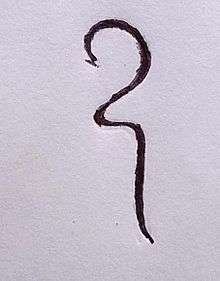 1
1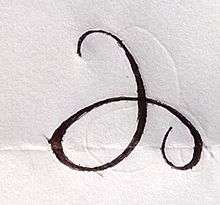 2
2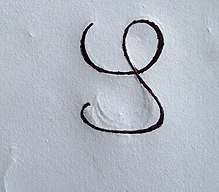 3
3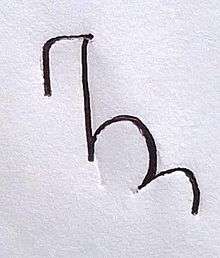 4
4 5
5 6
6 7
7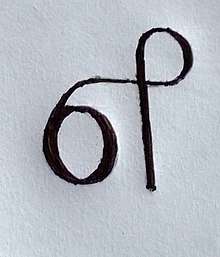 8
8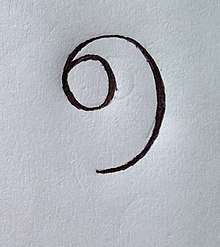 9
9
See also
References
- ↑ N. Subrahmanian (1996). Śaṅgam polity: the administration and social life of the Śaṅgam Tamils (3 ed.). Ennes Publications. pp. 235, 416. Retrieved 2 December 2015.
- ↑ Literary theories in Tamil: with special reference to Tolka:ppiyam. Pondicherry Institute of Linguistics and Culture. 1997. p. 135.